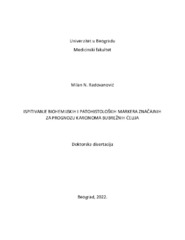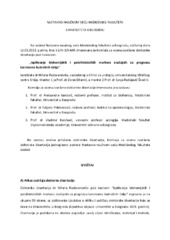Приказ основних података о дисертацији
Ispitivanje biohemijskih i patohistoloških markera značajnih za prognozu karcinoma bubrežnih ćelija
Examination of biochemical and pathohistological markers important for the prognosis of renal cell carcinoma
| dc.contributor.advisor | Džamić, Zoran | |
| dc.contributor.other | Radojević-Škodrić, Sanja | |
| dc.contributor.other | Isaković, Aleksandra | |
| dc.contributor.other | Pekmezović, Tatjana | |
| dc.contributor.other | Bančević, Vladimir | |
| dc.creator | Radovanović, Milan | |
| dc.date.accessioned | 2022-12-03T08:31:30Z | |
| dc.date.available | 2022-12-03T08:31:30Z | |
| dc.date.issued | 2022-07-06 | |
| dc.identifier.uri | https://eteze.bg.ac.rs/application/showtheses?thesesId=8840 | |
| dc.identifier.uri | https://fedorabg.bg.ac.rs/fedora/get/o:27041/bdef:Content/download | |
| dc.identifier.uri | https://plus.cobiss.net/cobiss/sr/sr/bib/78563593 | |
| dc.identifier.uri | https://nardus.mpn.gov.rs/handle/123456789/20910 | |
| dc.description.abstract | Karcinom bubrežnih ćelija (RCC) je najčešći maligni tumor bubrega kod odraslih. Javlja se u 85%- 90% svih malignih tumora bubrega kod odraslih. Najveća incidencija karcinoma bubrega se beleži kod ljudi između 60-70 godine starosti, češće kod muškaraca (1,5:1), dok se u 7% slučajeva dijagnostikuje kod osoba mlađih od 40 godina. Prema Vankuverskoj klasifikaciji iz 2004 postoje tri glavna histološka podtipa karcinoma bubrežnih ćelija i to: svetloćelijski tip RCC (engl. clear cell RCC - ccRCC), papilarni tip RCC (engl. papillary RCC - pRCC) i hromofobni RCC (engl. chromophobe RCC - chRCC) pri čemu je najčešći tip ccRCC (70-85% svih RCC). Veliki problem u terapijskom pristupu RCC jeste njegova rezistencija na hemioterapiju. Imajući u vidu da je angiogeneza ključan faktor koji doprinosi napredovanju svih tumora pa i RCC, kao i da apoptoza i autofagija mogu doprineti hemorezistenciji RCC smatrali smo značajnim upravo ispitivanje patohistoloških i biomolekulanih faktora kao potencijalnih markera RCC i prognostičkih faktora u odnosu na tok bolesti i njen ishod. Takođe, ispitivanjem angiogeneze, apoptoze i autofagije u različitim tipovima karcinoma bubrega bi se mogao poboljšati terapijski pristup, a samim tim i prognoza pacijenata obolelih od karcinoma bubrega, naročito onih sa metastatskom bolešću. U okviru ovog istraživanja su izvedene dve studije na istom uzorku. Uzorak su činili pacijenti sa postavljenom dijagnozom RCC (90 pacijenata) i pacijenti sa ccRCC (30 pacijenata) koji su hirurški lečeni na Klinici za Urologiju Kliničkog Centra Srbije. Jedna studija je obuhvatila patohistološko ispitivanje ekspresije p53, VEGF, survivina i beta katenina u različitim podtipovima RCC (90 pacijenata) i njihovu međusobnu korelaciju kao i njihovu korelaciju sa stadijumom, gradusom i ishodom bolesti. Za potrebe ovog dela istraživanja je primenjena imunohistohemijska metoda primenom metode tkivnog mikroniza (engl. tissue microarray - TMA). Druga studija je obuhvatila ispitivanje ekspresije gena i proteina uključenih u kontrolu procesa apoptoze i autofagije u ccRCC kao najčešćem tipu RCC (30 pacijenata). Za potrebe ovog segmenta istraživanja primenjene su RT-qPCR metoda i imunoblot analiza. Dobijeni rezultati su pokazali da je u tkivu RCC prisutna ekspresija p53, VEGF, survivina i beta katenina i da ekspresija ovih proliferativnih markera korelira pozitivno sa stadijumom i gradusom bolesti (izuzev beta katenina koji je pokazao negativnu korelaciju). Takođe je pokazano da između analiziranih markera nema međusobne korelacije. Istovremeno, ekspresija p53, VEGF i survivina pokazuje negativnu korelaciju sa dužim preživljavanjem dok ekspresija beta katenina pokazuje pozitivnu korelaciju. U tkivu ccRCC pokazana je povećana ekspresija iRNK za p21, p27, p53 tumorsupresor gene, Bax i Bad antiapoptotskih gena dok je ekspresija tumor supresora PTEN bila viša u peritumorskom tkivu. Ekspresija iRNK za markere autofagije p62, Atg4 i Uvrag je bila viša u tumorskom tkivu ccRCC... | sr |
| dc.description.abstract | 85% -90% of all malignant kidney tumors. The highest incidence of kidney cancer is recorded in people between 60-70 years of age, more often in men (1.5: 1), while in 7% of cases it is diagnosed in people younger than 40 years. According to the 2004 Vancouver classification, there are three main histological subtypes of renal cell carcinoma: clear cell type RCC (ccRCC), papillary type RCC (papillary RCC) and chromophobic RCC (chRCC). ). The most common type is ccRCC which makes 70-85% of all RCCs. A major problem with the RCC's therapeutic approach is its resistance to chemotherapy. Given that angiogenesis is a key factor which contributes to the progression of all tumors, including RCC, and that apoptosis and autophagy may contribute to RCC chemoresistance, we considered as an important goal of this study to examine pathohistological and biomolecular factors as potential markers of RCC and prognostic factors in relation to the course and outcome of the disease. Also, the examination of angiogenesis, apoptosis and autophagy in different types of kidney cancer could improve the therapeutic approach, and thus the prognosis of patients with kidney cancer, especially those with metastatic disease. Within this research, two studies were performed on the same sample. The sample included the patients diagnosed with RCC (90 patients) and patients with ccRCC (30 patients) who were surgically treated at the Clinic of Urology of the Clinical Center of Serbia. One study included pathohistological examination of p53, VEGF, survivin, and beta catenin expression in different RCC subtypes and their correlation as well as their correlation with the stage, grade, and disease outcome (90 patients). In this part of the research, the immunohistochemical analysis including the tissue microarray (TMA) method was performed. The other study included apoptosis and autophagy related genes and proteins in the ccRCC as the most common type of RCC (30 patients). In this segment of the research RT-qPCR method and immunoblot analysis were used. The obtained results demonstrate that the expression of p53, VEGF, survivin and beta catenin is present in RCC tissue and that the expression of these proliferative markers correlates positively with the stage and degree of the disease (except beta catenin which showed a negative correlation). No correlation was found between the analyzed markers. At the same time, the expression of p53, VEGF and survivin shows a negative correlation with longer survival while the expression of beta catenin shows a positive correlation. In ccRCC tissue, increased mRNA expression was shown for p21, p27, p53 tumor suppressor genes, Bax and Bad antiapoptotic genes while PTEN tumor suppressor expression was higher in peritumoral tissue. mRNA expression for autophagy markers p62, Atg4, and Uvrag was higher in ccRCC tumor tissue... | en |
| dc.format | application/pdf | |
| dc.language | sr | |
| dc.publisher | Универзитет у Београду, Медицински факултет | sr |
| dc.rights | openAccess | en |
| dc.rights.uri | https://creativecommons.org/licenses/by-nc-nd/4.0/ | |
| dc.source | Универзитет у Београду | sr |
| dc.subject | RCC, apoptoza, autofagija | sr |
| dc.subject | RCC, apoptosis, autophagy | en |
| dc.title | Ispitivanje biohemijskih i patohistoloških markera značajnih za prognozu karcinoma bubrežnih ćelija | sr |
| dc.title.alternative | Examination of biochemical and pathohistological markers important for the prognosis of renal cell carcinoma | en |
| dc.type | doctoralThesis | |
| dc.rights.license | BY-NC-ND | |
| dc.identifier.fulltext | http://nardus.mpn.gov.rs/bitstream/id/147466/Disertacija_12847.pdf | |
| dc.identifier.fulltext | http://nardus.mpn.gov.rs/bitstream/id/152573/Referat.pdf | |
| dc.identifier.rcub | https://hdl.handle.net/21.15107/rcub_nardus_20910 |



